TOOLS
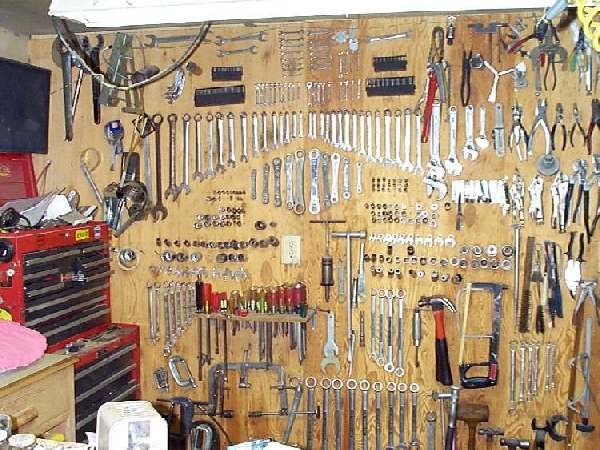
¶ Tools. You have to have lots of tools to work on motorcycles. So what does that mean? Do you have to go out and buy a $2000 master tool set to do good work? No, not at all. A basic tool kit is all you need. You can add tools as you need them. It's always nice to have pretty, shiny, new tools, but hey, the bolts don't care. They'll come apart with old tools, same as new. Start looking around... garage sales, 2nd hand stores...tell your friends you're looking for some tools. Most mechanics start out with old, junky tools and upgrade as money allows. This means there are lots of old tools floating around. Maybe they will sell cheap or even give them to you, so keep your eyes open for them.
If you are really new to tools, a good place to learn about what is out there is a tool catalog. Sears Craftsman tools put out a free one that is a good place to start. Almost all my tools are Craftsman. There is a good reason for that...they are guaranteed forever (well, maybe just till they go out of business.) If I break one, I just take it back to Sears, and they give me a new one. I've fished them out of dumpsters, bought broken ones from junk yards and take them back and I get a new one. There are others who give a lifetime warrenty, but I always know where a Sears is. I don't always know where the other guys are.
UPDATE: Sears seems to be slowly dying but you can still get Craftsman tools and replacements from Ace Hardware and Lowes.
To start with you're going to need some wrenches. Wrenches come in lots of types
and sizes.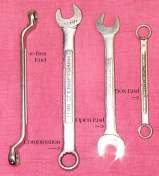 The handiest ones are Combination Wrenches. You will need sizes 6mm through 14mm, 17mm and 19mm to start. Two sets are nice, one for
the nut and one for the bolt head. A set of small, open end ignition wrenches is handy. Especially if the bike you are working on has points.
A set of inch (US) wrenches would be good too.
The handiest ones are Combination Wrenches. You will need sizes 6mm through 14mm, 17mm and 19mm to start. Two sets are nice, one for
the nut and one for the bolt head. A set of small, open end ignition wrenches is handy. Especially if the bike you are working on has points.
A set of inch (US) wrenches would be good too.
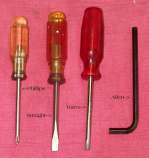 You will need lots of Screw Drivers. Small ones, large ones, big, long ones, small,short ones, short big ones and long small ones.
Well, you get the idea. There are all kinds of weird screw heads. Besides the ones we all know, Straight and Phillips, there are Allen, Torex, Square
and others. You will also use them for all kinds of unauthorized prying, chisling, levering and such. As Red Green says " Any tool can be the right tool."
You will need lots of Screw Drivers. Small ones, large ones, big, long ones, small,short ones, short big ones and long small ones.
Well, you get the idea. There are all kinds of weird screw heads. Besides the ones we all know, Straight and Phillips, there are Allen, Torex, Square
and others. You will also use them for all kinds of unauthorized prying, chisling, levering and such. As Red Green says " Any tool can be the right tool."
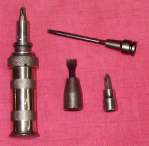 The Impact Driver is a must have tool. The steel Phillips head screws used on a large number of motorcycles really lock onto the threads in the
aluminum crankcases. You must have an Impact Driver to get them out. Impact Drivers come in both 3/8" and 1/2" drives. You can use screw driver bits
or sockets with them. To use an impact driver first select the right size of bit, then put it on the driver and onto the screw. Turn the body of the
driver in the direction you want to turn. This " cocks " the tool, so to speak. Now hit it on the end, with a hammer, good and hard, and off it comes...
the screw, that is. Remember to back up the part. If the part with the screw in it is not strong enough to take the hammer blow, it will break.
The Impact Driver is a must have tool. The steel Phillips head screws used on a large number of motorcycles really lock onto the threads in the
aluminum crankcases. You must have an Impact Driver to get them out. Impact Drivers come in both 3/8" and 1/2" drives. You can use screw driver bits
or sockets with them. To use an impact driver first select the right size of bit, then put it on the driver and onto the screw. Turn the body of the
driver in the direction you want to turn. This " cocks " the tool, so to speak. Now hit it on the end, with a hammer, good and hard, and off it comes...
the screw, that is. Remember to back up the part. If the part with the screw in it is not strong enough to take the hammer blow, it will break.
 Sockets come in 6, 8, and 12 points and 1/4", 3/8", 1/2", and bigger drives. The points refer to the way the socket grips the bolt or nut.
6 and 12 point work on hex head bolts and nuts. The 6 point has a very strong grip on the hex head. the 12 point has a weaker grip
Sockets come in 6, 8, and 12 points and 1/4", 3/8", 1/2", and bigger drives. The points refer to the way the socket grips the bolt or nut.
6 and 12 point work on hex head bolts and nuts. The 6 point has a very strong grip on the hex head. the 12 point has a weaker grip
 but allows the
socket to go on the bolt easier. I always try to get 6 point sockets. I don't think the 12 point are that useful. The drive refers to the
square that is used to drive the socket. 8 point sockets are used on the square nuts seen on farm machinery. You will need sockets in the
same sizes as your wrenches. Sockets below 10mm will use 1/4" drive handles. 3/8" drive goes from 10mm up to 19mm. 1/2" drive goes from 10mm
on up to 36mm or so. 3/8" seems to be the drive to use for most bike work.
but allows the
socket to go on the bolt easier. I always try to get 6 point sockets. I don't think the 12 point are that useful. The drive refers to the
square that is used to drive the socket. 8 point sockets are used on the square nuts seen on farm machinery. You will need sockets in the
same sizes as your wrenches. Sockets below 10mm will use 1/4" drive handles. 3/8" drive goes from 10mm up to 19mm. 1/2" drive goes from 10mm
on up to 36mm or so. 3/8" seems to be the drive to use for most bike work.
 The handles for these sockets come in all kinds of shapes, sizes, and styles. T-Handles are handy, as are rachet handles. Just pick the ones you like.
The handles for these sockets come in all kinds of shapes, sizes, and styles. T-Handles are handy, as are rachet handles. Just pick the ones you like.
 Socket extensions come in all sizes from 1 1/2" long on up. Get several. You can hook them together to get any length extension you want.
Socket extensions come in all sizes from 1 1/2" long on up. Get several. You can hook them together to get any length extension you want.
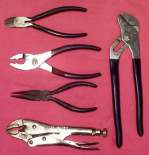 Pliers are useful for holding things tightly. They come in lots of shapes and sizes. Vice-Grip types are very useful. If you only have one make it a medium sized Vice-Grip. Better yet, get a whole bunch of them, you will use them.
Pliers are useful for holding things tightly. They come in lots of shapes and sizes. Vice-Grip types are very useful. If you only have one make it a medium sized Vice-Grip. Better yet, get a whole bunch of them, you will use them.
 No good mechanic ever uses a Crescent Wrench...but we all have a good selection of them hidden in our tool box! Now you would think that with as many
tools as I have, I would always have exactly the right wench for every nut and bolt. But, you would be wrong. I am always running across
bolts that nothing fits. For those bolts, I keep the trusty Crescent Wrench. So tell everyone you never use a Crescent Wrench and keep a good supply of them.
No good mechanic ever uses a Crescent Wrench...but we all have a good selection of them hidden in our tool box! Now you would think that with as many
tools as I have, I would always have exactly the right wench for every nut and bolt. But, you would be wrong. I am always running across
bolts that nothing fits. For those bolts, I keep the trusty Crescent Wrench. So tell everyone you never use a Crescent Wrench and keep a good supply of them.
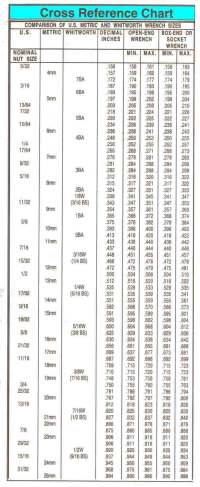 If it's a British bike like Triumph, BSA, Norton and the like, it will have nuts and bolts that are British Standard. These are also called Whitworth. You will need a set of these Wrenches if you work on British stuff.
Speaking about funny sized bolts, from time to time you will run across bolts and nuts that are rounded off or it's a weird size. If you measure the
bolt and compare it with this chart, you will be able to select a socket or wrench that is pretty close in size. Print it out on card stock, laminate it and put it in your toolbox. My thanks to Flanders Co., a motorcycle parts distributor, for giving me permission to reprint this chart from their catalog.
If it's a British bike like Triumph, BSA, Norton and the like, it will have nuts and bolts that are British Standard. These are also called Whitworth. You will need a set of these Wrenches if you work on British stuff.
Speaking about funny sized bolts, from time to time you will run across bolts and nuts that are rounded off or it's a weird size. If you measure the
bolt and compare it with this chart, you will be able to select a socket or wrench that is pretty close in size. Print it out on card stock, laminate it and put it in your toolbox. My thanks to Flanders Co., a motorcycle parts distributor, for giving me permission to reprint this chart from their catalog.
There are lots of other tools out there and the ones you will want will depend on the job you are doing. If you are just starting your tool box, here is what I would consider a good start.
The list is endless, but at least now you have a place to start.
Someone requested an easy way to print out the wrench referance. Here it is![]() , a bit small but printable. Remember to right click and left click "Save Target As..."
, a bit small but printable. Remember to right click and left click "Save Target As..."



 |
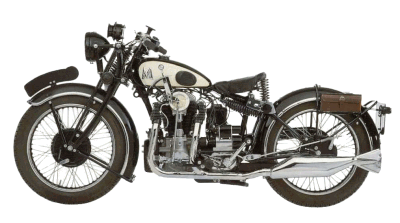 |
Copyright © 1999-2002 dansmc.com. All rights reserved. Updated in 2019